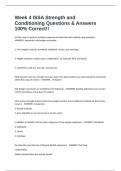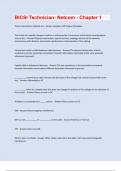Week 4 ISSA Strength and
Conditioning Questions & Answers
100% Correct!!
List four ways to perform resistance exercises and describe each method using examples: -
ANSWER1. Isometrics: side bridges and planks
2. Free weights: barbells, dumbbells, kettlebells, stones, and sand bags.
3. Weight machines: weight stacks, weight plates, air, hydraulic fluid, and bands.
4. Calisthenics: pull ups, step ups, and push ups.
With isometric exercise, strength increases only in the joint positions you work during the movement
within this range of motion: - ANSWERC. 15 degrees
Side bridges and planks are excellent for the following: - ANSWERB. building abdominal core muscles
vital for providing a strong base for support.
Most serious strength trainers prefer free weights to other more traditional methods for these three
reasons: - ANSWER1. Inexpensive
2. Readily available
3. Easy adaptable to any movement or muscle action
In addition to barbells, list four other categories of free-weight equipment: - ANSWER1. Dumbbells
2. Kettlebells
3. Stones
4. Sandbags
Describe the main features of Olympic barbell equipment. - ANSWER-7 feet long
-20 kg (45lbs)
-Better balanced than the average barbell
,-Hold more weight
Why are weight machines more preferable for beginning athletes? - ANSWERLower risk of injury.
They are also safer, much easier to set up, provide better support, require less skill, and can be more
comfortable.
List five weight machines provide resistance: - ANSWER1. Weight stacks
2. Weight plates
3. Air
4. Bands
5. Hydraulic fluid
What unique features do pull-ups, step-ups, and push-ups share? - ANSWERThey use bodyweight as
resistance, which is great for beginners and experienced athletes. Plus you can do them anywhere.
A well-rounded program for strength development should include these nine major muscle group
regions: - ANSWER1. Shoulders
2. Chest
3. Upper back
4. Arms
5. Abdomen
6. Low back
7. Thighs
8. Glutes
9. Calves
For these three groups of athletes, what types of strength activities should each emphasize? High-
power sport (football, basketball, and most track and field events, baseball, softball, and soccer) and
track and field: - ANSWERPower athletes: whole-body exercises like squats, lunges, step-ups, push-
presses, cleans, snatches, kettlebell swings and snatches, bench presses, and deadlifts. Core strength
should be focused on more than bodybuilding exercises.
Bodybuilders: muscle size (hypertrophy) and focusing on exercises that hit antagonistic muscle
groups.
,Thought question: Explain whether you agree or disagree that program design begins with individual
assessment, setting short- and long-term goals, creating a training plan, and requiring a mandatory
medical history regardless of the sport. The program must identify weaknesses and past injuries and
include meetings with coaches and assistants to identify the participant weaknesses and develop
appropriate resistance training programs to remedy deficiencies. - ANSWERI totally agree with this.
Without an individual assessment, how are you going to know where your client is in strength,
endurance, flexibility, and mobility. What they need to improve upon and what exercises to avoid
and which ones to focus on. Short- and long-term goals must be set, otherwise your client has no
idea what they are working towards. From the beginning, there must be a structured training plan to
track progress and to show your client that they are improving. This way they won't lose motivation.
Describe the principle of overload. - ANSWERStrength is increased by having your muscles work
against increased resistance. However, this can also be done through changing angles, adding more
sets, reps, and distance.
What is the optimal number of days per week to overload specific muscles? - ANSWER2 - 3 days per
week
Give two examples of a split-routine. - ANSWER1. Upper body for two days
2. Lower body for two days
Discuss the role rest plays in improving overall muscle strength. - ANSWERMuscles will not grow in
size and strength if they do not receive adequate rest. No rest will just interfere with skill
development. Rest does not mean you just don't workout for a couple days. You should be training
not as intensely and not going to failure. This includes going for walks, working out with bands, doing
mobility work, or working out with lighter weight.
Compare and contrast the important differences between circuit training and cross-training. -
ANSWERCircuit training: multiple exercises performed in a round/set in a workout.
Cross-training: performing different exercises on different days.
They both help with developing general fitness, muscular endurance, and strength.
Set: - ANSWERGroup of reps followed by rest.
, Load: - ANSWERD. Expressed as percentage of 1RM or max weight lifted for multiple reps.
One-repetition max: - ANSWERB. Maximum weight that can be lifted once.
Use two equations to determine the 1RM for a male college football player (bodyweight 216 pounds)
who successfully completes 35 reps with a 25-pound barbell: - ANSWER-Equation 1: Brycki equation
1RM (25) = 216 x (1.028 - (0.0278 x number of reps)) = 221.075 1RM
3942
Equation 2: Baechle
216 x (0.033 x 35) = 249.48
466
How would you rate this player's 1RM based on his 216-pound bodyweight based on a scale of poor,
fair, good, very good, and excellent? - ANSWERFair - very good
Compute the average for the 1RM determined from equations 1 and 2 and divide the player's
bodyweight by the average 1RM. - ANSWER-Average 1RM = 466
-Average 1RM / bodyweight = 466/216
Give two specific examples of how you would use a 1RM as a motivational tool: - ANSWER
When determining the number of sets in a workout, explain whether you should arrange the sets by
doing large muscle exercises first or small muscle exercises first. - ANSWERLarge muscle exercises
should be before small muscle exercises because large muscle exercises require more energy to
perform.
Explain why short rest intervals are superior to longer rest intervals for NOT compromising strength
and muscle mass. - ANSWERShorter rest intervals improve endurance but don't exactly work well
when performing strength movements. Strength movements require longer rest intervals for
adequate recovery. However, small muscle exercises can benefit from shorter rest intervals,
especially when performing circuit training.





